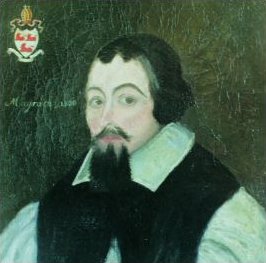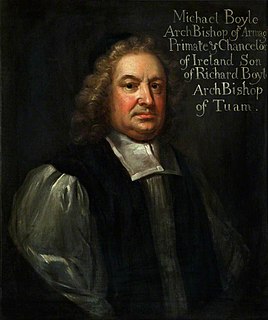Related Research Articles

The Desmond Rebellions occurred in 1569–1573 and 1579–1583 in the Irish province of Munster.
Tadhg Mac Cárthaigh c. 1455 – 25 October 1492, was an Irish ecclesiastic. He was a bishop who never ruled his see, even though he was appointed to two of them: Bishop of Ross, Ireland in 1482 and Bishop of Cork and Cloyne in 1490. His feast day is 25 October.

Maolmhuire Mag Raith, was an Irish priest and archbishop born in County Fermanagh, Ireland. He came from a family of hereditary historians to the O'Brien clan. He entered the Franciscan Order and was ordained to the Roman Catholic priesthood. The Vatican later appointed him the Bishop of Down and Connor in Ireland, but he converted to the Anglican Church of England and became the Protestant Archbishop of Cashel. Mag Raith is viewed with contempt by both Protestant and Catholic historians, owing to his ambiguous and corrupt activities during the Reformation. He also served as a member of the Parliament of Ireland.
John Fitzedmund Fitzgerald was the hereditary Seneschal of Imokilly, an Irish nobleman of the Welsh-Norman FitzGerald dynasty in the province of Munster, who rebelled against the crown during the reign of Queen Elizabeth I of England.
William Paul Colton, known as Paul Colton, is the Church of Ireland's Bishop of Cork, Cloyne and Ross

The Buttevant Franciscan Friary is a 13th-century Franciscan Friary is situated in the middle of the town of Buttevant, County Cork, Ireland.
The Second Desmond Rebellion (1579–1583) was the more widespread and bloody of the two Desmond Rebellions in Ireland launched by the Fitzmaurice/FitzGerald Dynasty of Desmond in Munster against English rule. The second rebellion began in July 1579 when James Fitzmaurice landed in Ireland with a force of Papal troops, triggering an insurrection across the south of Ireland on the part of the Desmond dynasty, their allies, and others who were dissatisfied for various reasons with English government of the country. The rebellion ended with the 1583 death of Gerald FitzGerald, 14th Earl of Desmond, and the defeat of the rebels.
William Maziere Brady (1825–1894) was an Irish priest, ecclesiastical historian and journalist who converted to Roman Catholicism from Anglicanism.
The Bishop of Cloyne is an episcopal title that takes its name after the small town of Cloyne in County Cork, Republic of Ireland. In the Roman Catholic Church, it is a separate title; but, in the Church of Ireland, it has been united with other bishoprics.
William FitzGerald (1814–1883) was an Anglican bishop, first of Cork, Cloyne and Ross and then of Killaloe and Clonfert.

The Collegiate Church of Saint Mary the Virgin, also known as St Mary's Collegiate Church, is a large Anglican church in Youghal, east County Cork, Ireland. Dating to roughly 1220 and dedicated to the Virgin Mary, it is part of Youghal Union of Parishes, in the United Dioceses of Cork, Cloyne and Ross.
The Diocese of Ross was a separate diocese situated in south-west Ireland. Following the Reformation, there were two dioceses. In the Church of Ireland, the diocese is now part of the Diocese of Cork, Cloyne and Ross. In the Roman Catholic Church, it is part of the Diocese of Cork and Ross. In the 19th century, an exclave of the diocese existed around that part of the Beara peninsula in County Cork including the area around Glengariff though not as far east as Bantry. The main diocesan territory was centred on the towns of Baltimore, Skibbereen, Rosscarbery and Clonakilty which lie along the modern national road N71.

The Cathedral Church of St. Fachtna, also known as the Cathedral Church of St Faughan,Ross Cathedral, and Rosscarbery Cathedral, is a cathedral of the Church of Ireland in Rosscarbery, County Cork in Ireland. Located in the ecclesiastical province of Dublin, it is the smallest cathedral in Ireland. Having once been the mother church of the Diocese of Ross, it is now one of three Anglican cathedrals in the United Dioceses of Cork, Cloyne and Ross, alongside Saint Fin Barre's Cathedral and Cloyne Cathedral.

Michael Boyle, the younger was a Church of Ireland bishop who served as Archbishop of Dublin from 1663 to 1679 and Archbishop of Armagh from 1679 to his death. He also served as Lord Chancellor of Ireland, the last time a bishop was appointed to that office.
Roger Boyle was an Irish Protestant churchman, Bishop of Down and Connor and Bishop of Clogher.

The Diocese of Cloyne is a Roman Catholic diocese in Ireland. It is one of six suffragan dioceses in the ecclesiastical province of Cashel.
John Fitzedmund Fitzgerald was the hereditary Seneschal of Imokilly, an Irish nobleman of the originally Welsh-Norman FitzGerald dynasty in the province of Munster.

The Archdeacon of Cloyne was a senior ecclesiastical officer within the Diocese of Cloyne until 1835; and then within the Diocese of Cork, Cloyne and Ross until 1986 when it merged with the Archdeaconry of Cork. As such he was responsible for the disciplinary supervision of the clergy within the Cloyne Diocese.

John Sleyne was Roman Catholic Bishop of Cork and Cloyne and Apostolic Administrator of the diocese of Ross, who was an enthusiastic patron of the Gaelic language and culture, and an advocate of the severely repressed Roman Catholic population, in Ireland during the early period of the Penal Laws. He was one of only two bishops to minister in Ireland at the end of the 17th century. Sleyne was very learned in languages and moral theology, and had traveled widely. He was known to and had interactions with kings, queens, popes and wider cultural and religious establishment throughout Ireland and Europe. Because Sleyne "remain[ed] in the kingdom contrary to the [penal] law", of the time, he went into hiding. He was eventually brought before the courts in 1698 and spent five years in prison in Cork Gaol. During his time as Bishop, both as fugitive and prisoner, Sleyne ordained many priests and consecrated several bishops in Ireland. He was eventually exiled to Portugal, on 11 February 1703, where he was given shelter in the Irish Dominican Convento do Bom Sucesso, Lisbon. He died in Portugal on 16 February 1712, aged 74 years and is buried at the altar of the Sacred Heart in the Church of Nossa Senhora do Bom Sucesso.
Bishop William Coppinger (1753-1830) was an Irish Catholic priest, who served as Bishop of Cloyne and Ross, from 1791 until his death.
References
 This article incorporates text from a publication now in the public domain : Lee, Sidney, ed. (1893). "Lyon, William". Dictionary of National Biography . Vol. 34. London: Smith, Elder & Co.
This article incorporates text from a publication now in the public domain : Lee, Sidney, ed. (1893). "Lyon, William". Dictionary of National Biography . Vol. 34. London: Smith, Elder & Co.